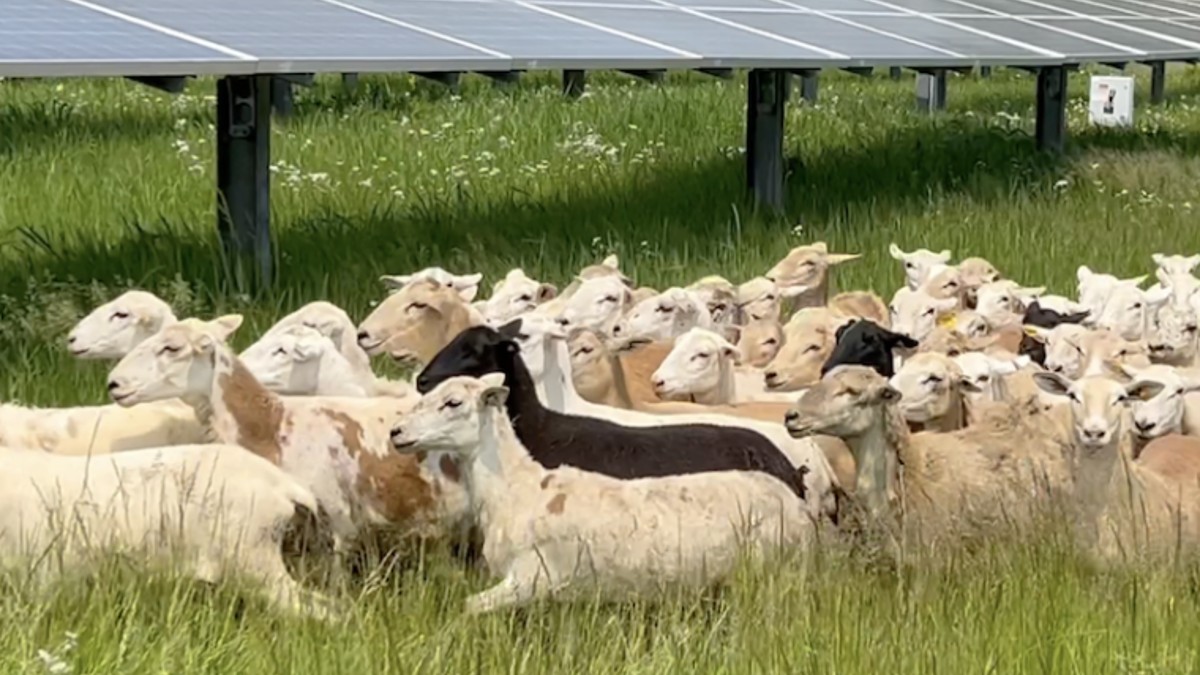
Up to 200 sheep will be grazing at Oberlin College’s 2.7 megawatt (MW) solar farm this summer, ending the need for mowing – and creating a lot of other wins as well.
Oberlin College’s ground crew have complained about how difficult and expensive it was to maintain the field upon which the 13-year-old solar farm sits. So the college’s campus energy and resource manager, Joel Baetens, decided to try agrivoltaics – pairing solar power with agriculture – by bringing in sheep to graze and aerate the grass growing around the solar farm.
On May 24, around 70 sheep were delivered from a farm to Oberlin’s fenced-in, 10-acre solar farm north of the campus. Two border collies helped to settle the first delivery of sheep in at their temporary home, and the sheep will be brought to Oberlin’s solar farm a couple times in the summer to graze. More sheep drops will soon up the numbers to around 200.
Solar and sheep are a great pair: Solar panels provide shade and shelter for the sheep, and the sheep trim the grass – and eat for free. Plus, the shade the panels create reduces heat and light underneath, thus helping to conserve water.
The cost of the sheep is just a fraction of the $30,000 it would cost to mow Oberlin’s solar farm, and they’ll reduce the carbon impact of maintaining the solar fields.
Baetens told the Chronicle-Telegram:
So we’re paying them just like we’d pay a lawnmowing service. The deal is they’ve got to get the grass down to a certain amount and keep it there.
Top comment by Bart te Molder
Agrovoltaics make a lot of sense, not just for grassland.
Many of the plants we cultivate were originally forest plants, and will thrive in a forest like environment - shaded, humid, fairly constant temperatures, not too much wind.
Yet we farm them on open fields where they are fully exposed to the sun and wind.
These plants will use a lot of water as they try to protect their leaves from overheating. When they run out the pores have to close and photosynthesis stops.
But a canopy of PV panels reduces the heat by day and acts as a wind breaker. As the sun moves across the sky the shades of the panels move over different plants, giving each of them their moment of sunlight. At night the exposed panels cool down further than the ground and the plants on it, collecting moisture that drips down to the plant that would otherwise be unavailable.
Not all plants benefit equally from a solar canopy, but potatoes f.i. have a higher yield canopy than they would have in an open field.
In general, crop yields are good while using way less water. You'd almost put canopies over fields just for that, the electricity is just an added bonus.
Read more: An Ohio company just landed the largest state EV bus contract ever
Photo: Erich Burnett/Oberlin College
Due to shifts in solar policy, renters and homeowners in certain states now have access to subscribe to a local community solar farm. Community solar typically saves you 5-15% depending on where you live, it’s quick and easy to sign up (no upfront costs), and there’s no need for any installation of panels on your property. Save money and help the environment by utilizing the EnergySage Community Solar Marketplace to explore all the solar farms available to you. They even have dedicated Energy Advisers to answer any questions you have about community solar and help you sign up!
FTC: We use income earning auto affiliate links. More.




Comments